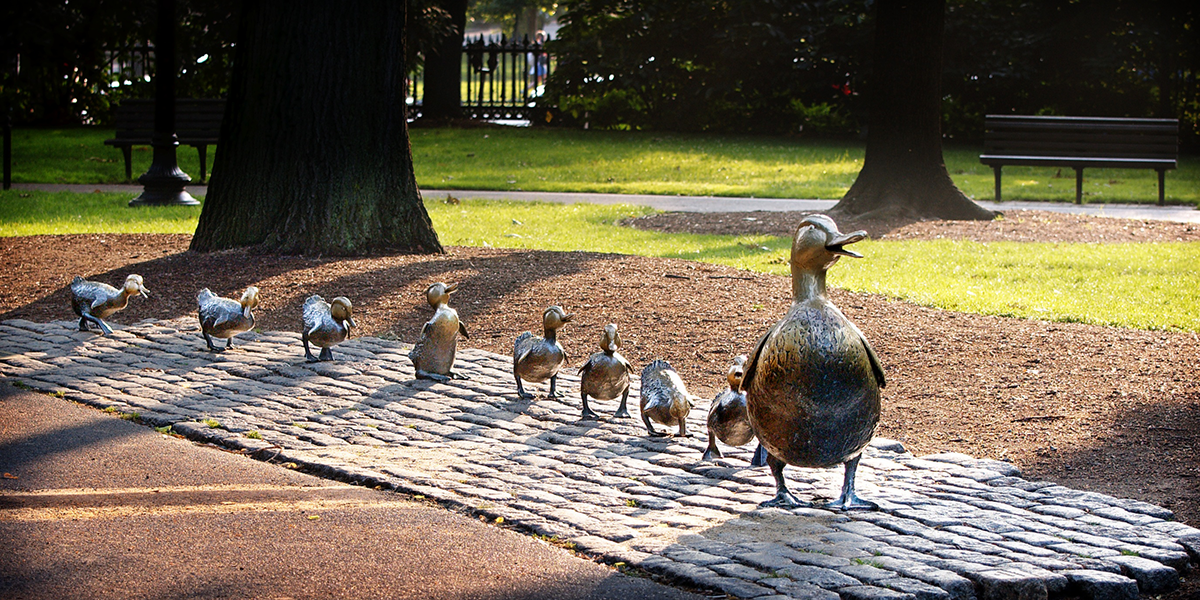Of course, there are scads of duck characters in the realm of children’s literature, including Dab-Dab the housekeeping duck in the Doctor Dolittle series. The books were written by Hugh Lofting beginning in the 1920s and If you’re unfamiliar with the stories or the movies (there’s a 1967 version starring Rex Harrison and a later […]

Of course, there are scads of duck characters in the realm of children’s literature, including Dab-Dab the housekeeping duck in the Doctor Dolittle series. The books were written by Hugh Lofting beginning in the 1920s and If you’re unfamiliar with the stories or the movies (there’s a 1967 version starring Rex Harrison and a later series from the late-90s with Eddie Murphy), the doctor has the ability to speak with and understand animals. Zaniness ensues.
The Wind in the Willows by Kenneth Grahame features some ticklish and a tad indignant ducks who even get their own “ditty,” written by a rat with poetic aspirations. Then there are Mr. and Mrs. Mallard, and their children Jack, Kack, Lack, Mack, Nack, Ouack, Pack, and Quack from the book Make Way for Ducklings, written and illustrated by Robert McCloskey. The book, first published in 1941, tells the story about a duck family who decides to make their home on an island in the lagoon at Boston Public Garden. Cuteness ensues.
The author and illustrator Marjorie Flack has given the world two great children’s books featuring ducks, The Story about Ping, and Angus and the Ducks, both from the 1930s. The first tells the story of Ping, a small Chinese duck lost on the Yangtze River. The second is about a rascally little Scottish Terrier who sneaks out of the house and meets a pair of ducks who live on the other side of the hedge. Hilarity ensues.
One of the most famous purported duck stories of all time, The Ugly Duckling,written by Hans Christian Andersen in 1843, isn’t (spoiler alert!) about a duck at all. The main character is actually a swan, so really it was all just a case of mistaken identity or species misidentification or something along those lines. The theme of the story is supposed to be about personal transformation but in reality it’s about realizing you shouldn’t listen to idiots who try to pigeonhole you. Since we’ve obviously just channeled Holden Caulfield in the previous sentence this may be the perfect segue for a look at the ducks in The Catcher in the Rye.
J.D. Salinger’s novel, first published in 1951, includes some Central Park ducks as a symbolic leitmotif. Holden Caulfield muses about where the ducks go to in the winter on several occasions in the novel and the plight of the waterfowl is tied to that of the main character. Alienation ensues.
Ducks have even made it into the world of poetry. Two examples run the extreme from whimsical to wistful. The first, “The Duck,” is by mid-20th century poet Ogden Nash, who specialized in funny, light verse. The pithy poem focuses on the bird’s sillier attributes. The second poem, “To A Waterfowl,” written by the polar opposite of Nash, William Cullen Bryant, was published in 1818 and focuses on the idea of a higher power guiding us on our life’s journey. We must admit that Bryant doesn’t get specific about what type of waterfowl he’s musing about, but we’re going with a duck, and since Bryant’s been dead for nearly 140 years, he can’t disagree. Rhythm and meter ensue.
Whether cute or contemplative, ducks have made their mark on literature and will hopefully continue to inspire writers and illustrators of the future to new heights of artistic excellence – or at least comic silliness.
Image via Flickr user theilr.